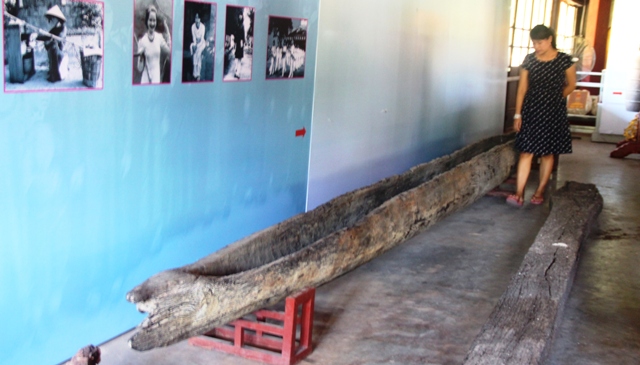
Friday, 04/08/2017 08:15
(GMT+7)
Dug-out canoe - a precious artifact
TTH.VN - Thua Thien Hue Museum of History is displaying a dug-out canoe 9.4m in length, with a perimeter of 1.44m and is 0.4m wide and 5 to 6cm thick. The boat was accidentally discovered by a sand excavation person in August 2008, at the upper Perfume River, near the Tuan fork. According to preliminary findings of Hue cultural researchers, this canoe was made from Hopea pierrei hance timber, a popular wood species in Hue. Through the chiseled marks by ax, it can be seen that this canoe was crafted by hand, dating to the time of the Nguyen lords, which was more than 200 years ago. This is a particularly valuable dug-out canoe.

The dug-out canoe is preserved at Thua Thien Hue Museum of History. Photo: Phan Thanh
The above-mentioned ancient boat is the longest one among dug-out canoes found in Vietnam. According to researchers, the owner of this canoe may have been a member of the Mon-Khmer group, a minority ethnic group in the Vietnamese ethnic community who once lived upstream of the Perfume river. By comparison with the boat of the Khmer people today, there are many similarities, especially with regard to the slim and distinctive form and shape. Khmer people believe that the origin of today's ngo canoes is also from the dug-out canoe.
The boat is being displayed and preserved in Di Luan Hall of the Provincial Museum of History. This is a rare and precious artifact. This artifact can help researchers to understand the history, culture and life of the ancient inhabitants who once lived upstream of the Perfume River. Along with some other valuable objects, such as the Dong Son bronze drum discovered in Phong My, the Van Trach altar found in Phong Thu which have been recognized as national treasures, the dug-out canoe also contributes to the diversity of the display system. This is considered as a precious antique and will be frequently displayed to visitors.
The greatest concern and difficulty now is how to protect and preserve such a precious antiquity as this dug-out canoe against the damage of time, while preservation technology in the our museums is now still done manually and does not really meet the requirements. At the same time, it also needs an appropriate displaying space to serve visitors and promote the value of this artifact. The artifact is made from wood material from a long time ago, dating hundreds of years. This kind of object has also long been on the river bed, so it was well adapted to the water environment. Thus, once it has been picked up and displayed in a harsh weather, high temperatures will cause the fibers to gradually peel off. Without proper display and storage solutions, these precious objects will be damaged and even ruined by time.
By Ngoc Kiem